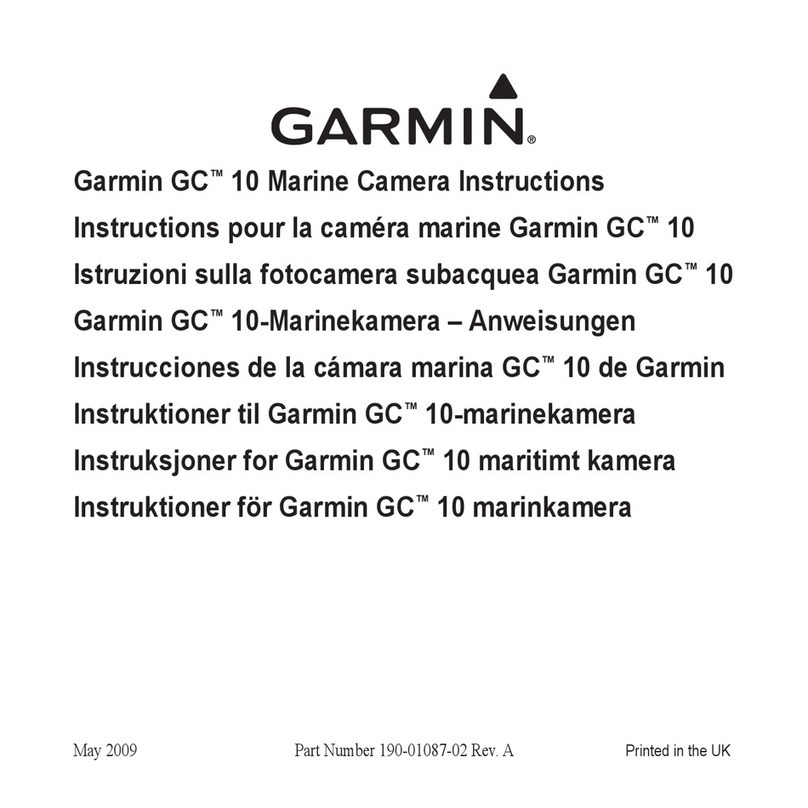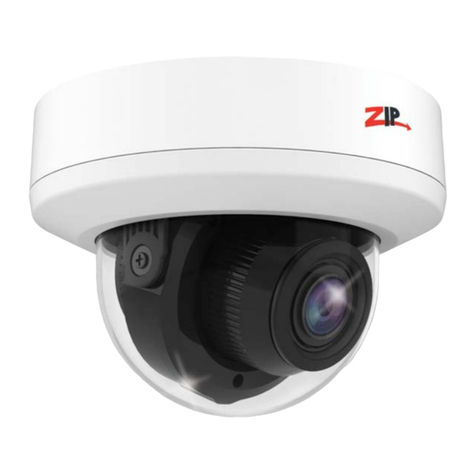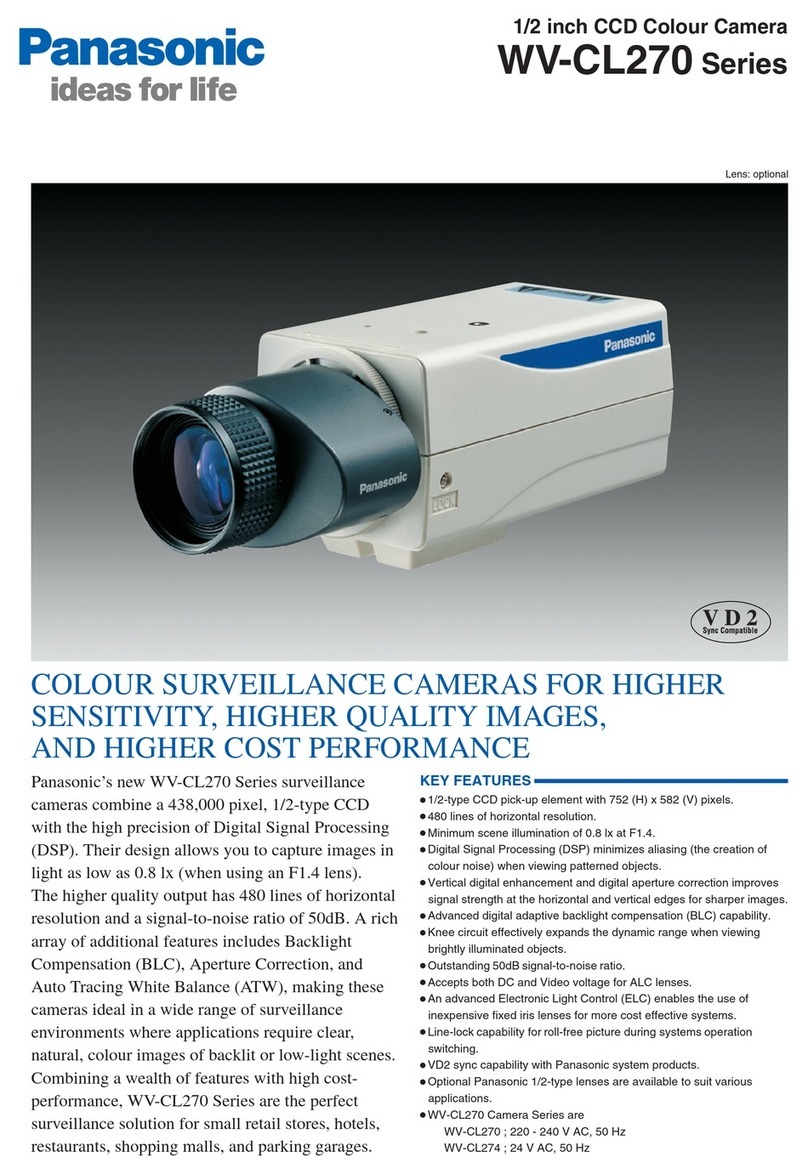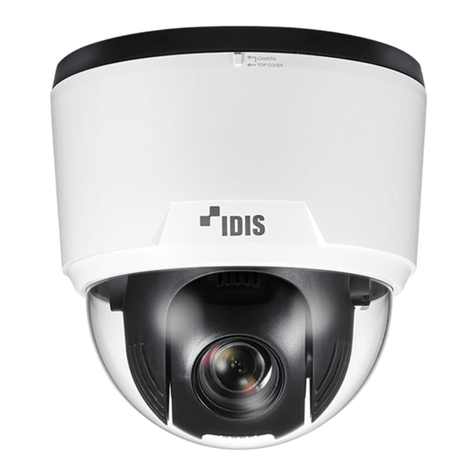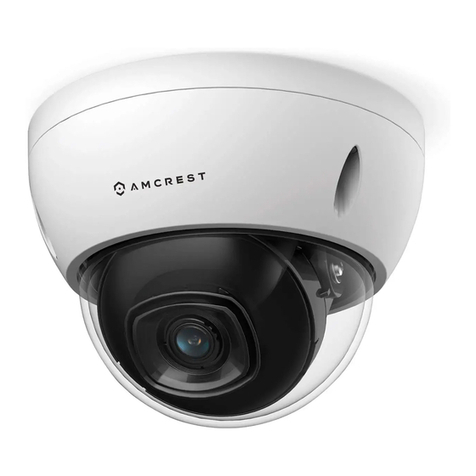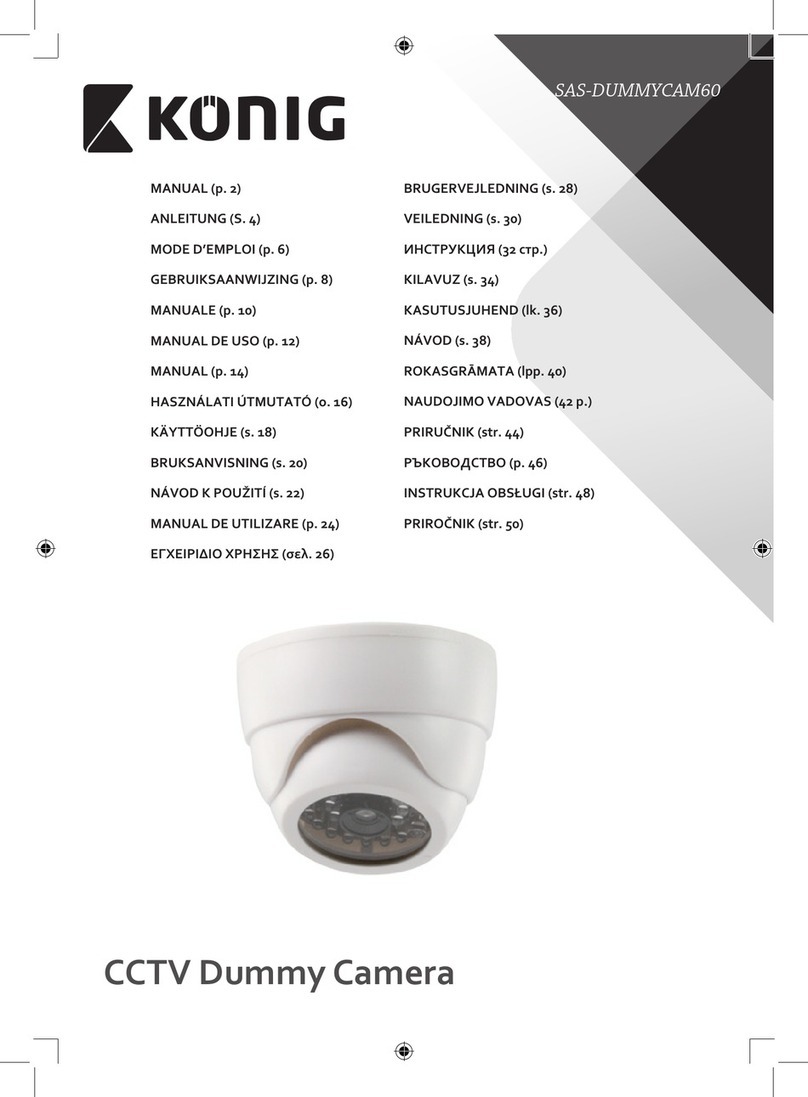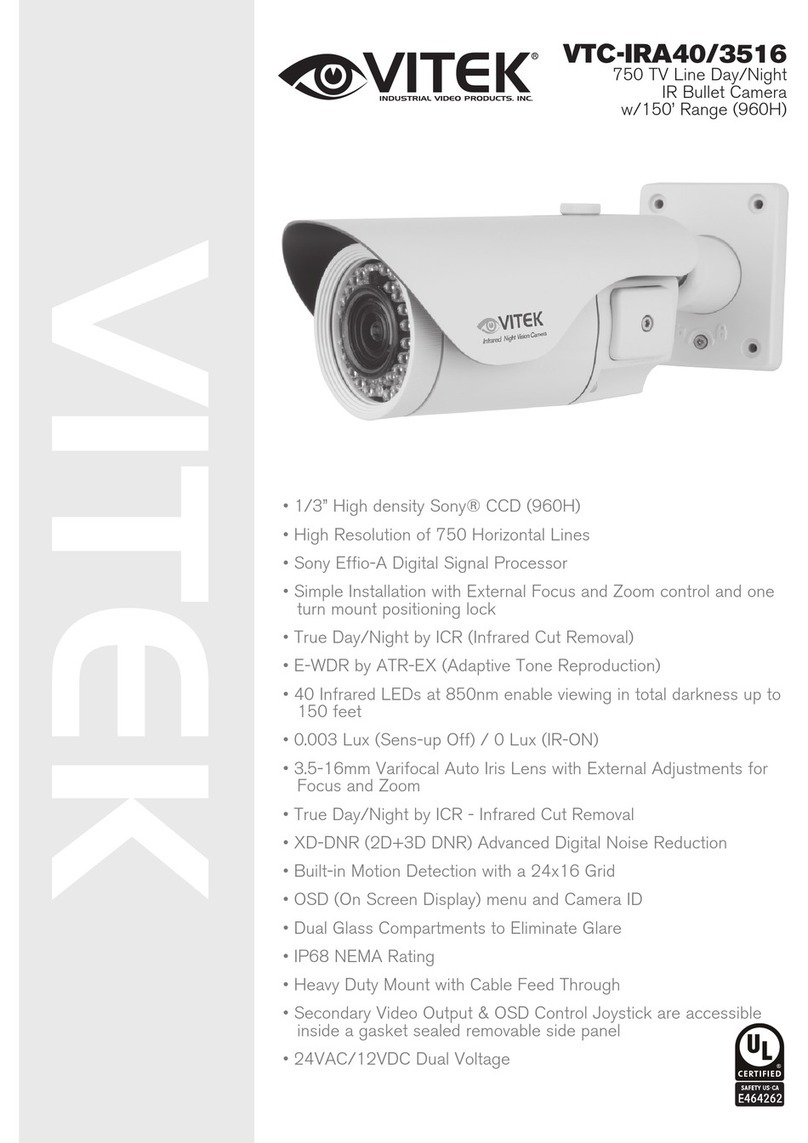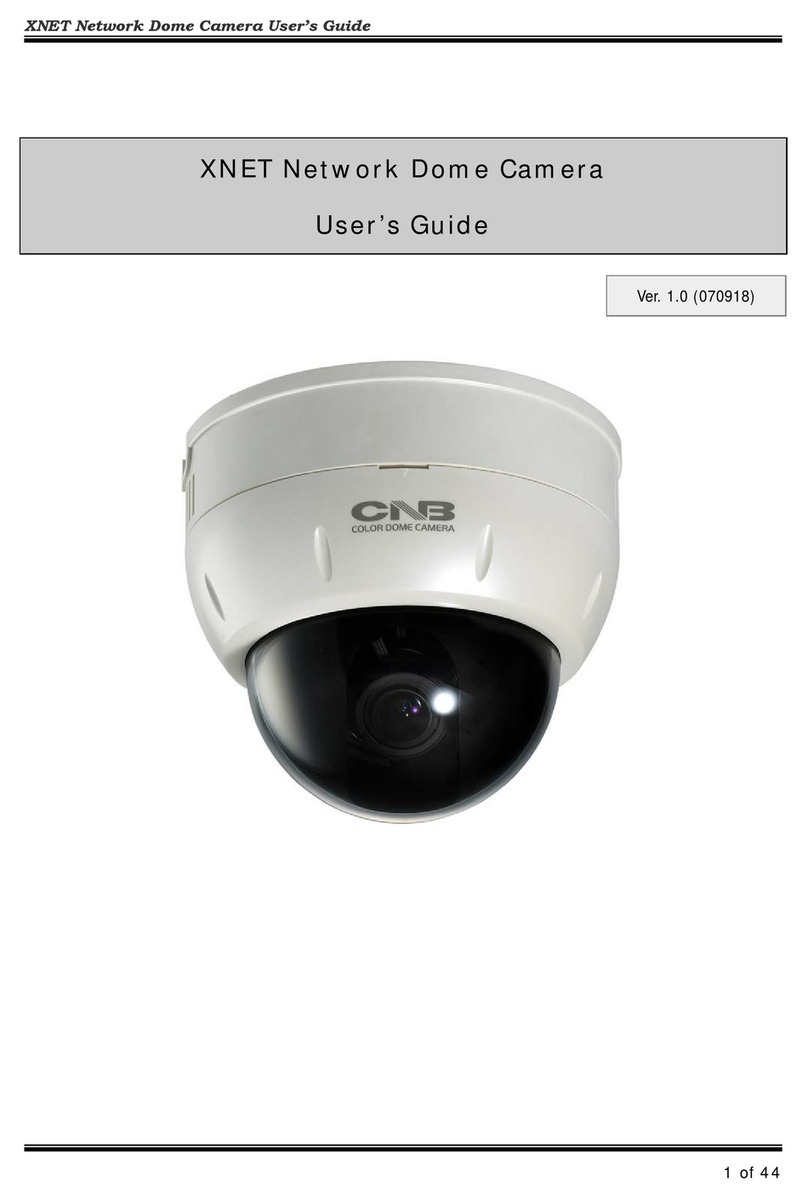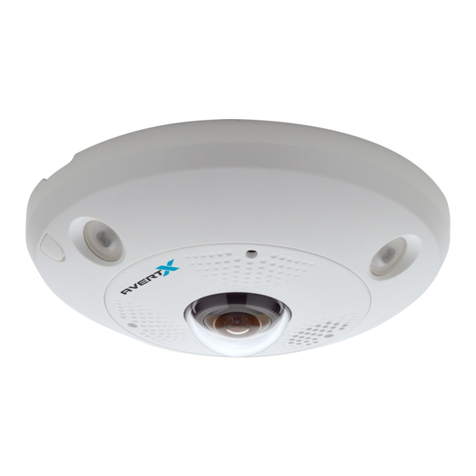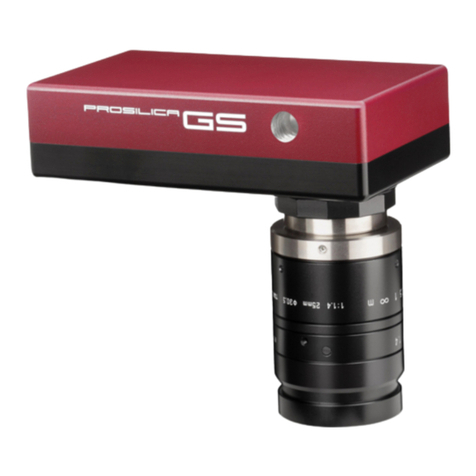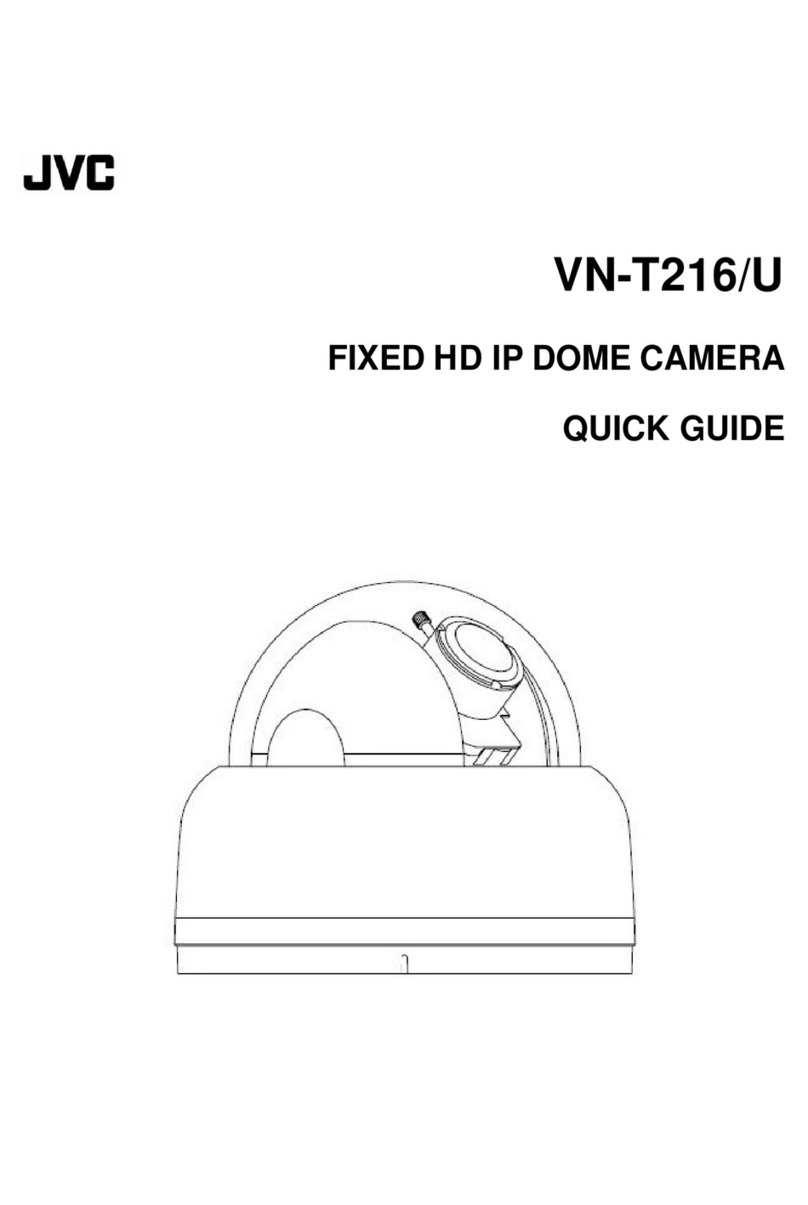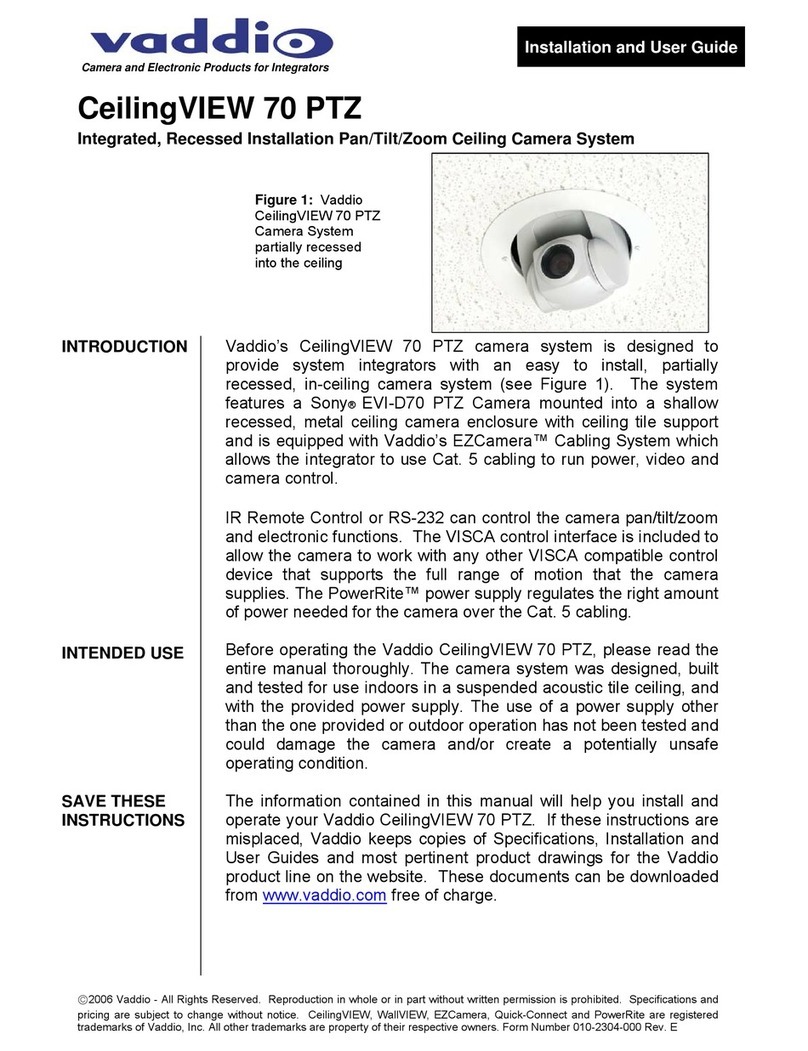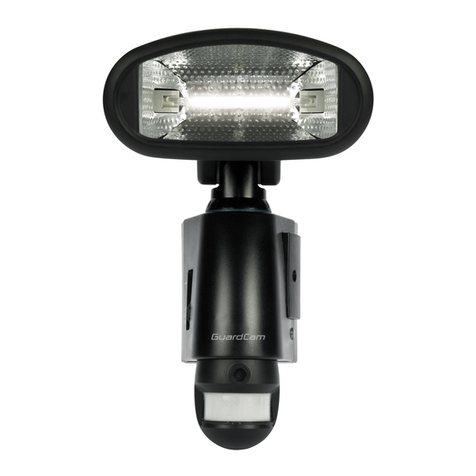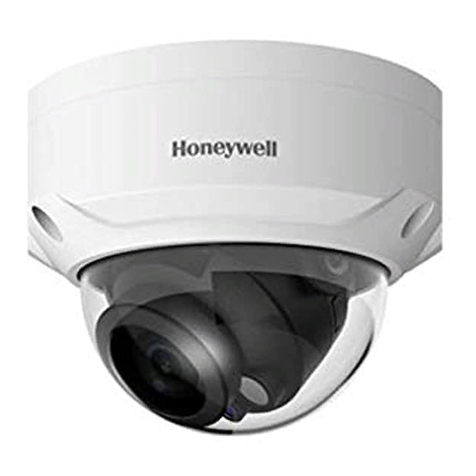Thermal-Eye TSC4500 Instructions for use

EXPORT CONTROL NOTICE – This technical data and software is
considered as Technology Software Publicly Available (TSPA) No
License Required (NLR) as defined in Export Administration
Regulations (EAR) Part 734.7-11.
Application Manual for the
Thermal-Eye™
Thermal Security Camera
Copyright L3 Communications
All Rights Reserved

PN 4000161-1 Rev C
2
W E L C O M E
TO THE WORLD
OF INFRARED!
Worldwide Patent Rights Reserved.
This product is covered by one or more of the following patents:
U.S. Patent Nos.: 5,288,649; 5,367,167; 6,267,501; 6,586,831; 6,521,477;
6,690,014; 6,479,320; and under license to 5,196,703.
Euro.Pat.Appln. 1159591.
Additional Patents Pending.
www.Thermal-Eye.com
L3 Communications Infrared Products (L-3 IP)
(Formerly Raytheon Commercial Infrared)
13532 North Central Expressway
PO Box 741148, MS 37
Dallas Texas 75374

PN 4000161-1 Rev C
3
Important Safeguards
WARNING
WARNINGWARNING
WARNING
WARNING:
WARNING:WARNING:
WARNING: TO REDUCE THE RISK OF ELECTRIC
SHOCK, DO NOT OPERATE WITH CAMERA COVER
REMOVED.
DO NOT OPEN COVERS AS THERE ARE NO
USER-SERVICEABLE PARTS INSIDE. REFER
SERVICING TO QUALIFIED SERVICE PERSONNEL.
1) Instructions: Read all safety and operating instructions
before operating your Thermal Security Camera.
2) Cleaning: To clean camera housing, use only a soft cloth
dampened with water. To clean camera lens, use a soft
cotton cloth and mild neutral soap diluted with lukewarm
distilled water (1 part soap to 100 parts water), followed by
use cotton swab or lens cleaning cloth dampened with
reagent grade isopropyl alcohol or acetone. Acetone will
damage plastic components of the camera.
3) Servicing: Do not remove the cover. There are no
user-serviceable parts inside. Refer all servicing to qualified
service personnel. Opening the TSC4500 will void your
warranty.
4) Power Sources: This product should be operated only from
the type of power source indicated on the marking label. For
products intended to operate from battery power, or other
sources refer to the operating instructions.
5) Restriction of Use Environments: The unit is not intended
or warranted for use in the following conditions. Damage
resulting from such exposure would not be covered by the
warranty.
Unit is intended for outdoor applications. A solar
shield is available to limit sun’s heating of the
TSC4500 body.
Unit is not intended to operate submerged in water.
However, the TSC4500 is designed to withstand
immersion or exposure to rain or high humidity.

PN 4000161-1 Rev C
4
Unit is not intended for exposure to a salt-water
atmosphere.
Unit is not intended for dynamic–mount applications,
such as on vehicles or heavy machinery, in which
transmitted vibration is continuously sustained.
Unit (whether powered On or Off) is not intended for
viewing of direct or indirect (reflected) sunlight. Unit
is intended for non-horizon exposure looking
downward from intended mounting plane. Exposure
to the sunlight, for even very short periods of time,
may permanently damage the camera and therefore
nullify any warranties.
Unit is not intended for intentional or unintentional
exposure directed towards solar activities, welding, or
other activities of similar heat dynamics, which if
performed may damage the camera and therefore will
nullify any warranties.

PN 4000161-1 Rev C
5
SECTION 1: INTRODUCTION ......................................... 6
INFRARED IMAGING ..............................................................6
THE TSC4500
TM
PRODUCT LINE ...........................................6
FEATURES AND OPTIONS: .............................................9
Performance................................................................... 11
Lens Option Capability for TSC4500............................. 11
Electrical........................................................................ 11
Interfaces .......................................................................11
Environmental................................................................ 11
Physical (25
o
HFOV) ..................................................... 12
Physical (12
o
HFOV) ..................................................... 12
SECTION 2: CARE AND MAINTENANCE.................... 13
CLEANING OF OPTICS .........................................................13
RESTRICTIONS OF USE ........................................................13
SECTION 3: INSTALLATION INSTRUCTIONS .......... 14
MOUNTING THE CAMERA ...................................................14
SYSTEM INTERFACE CONNECTOR .......................................14
CONNECTING INPUT POWER ...............................................15
VIDEO OUTPUT ...................................................................16
USER INTERFACE WITH TSC4500.......................................16
RS-232 Serial Communication: ..................................... 17
Using RS-232/485 Serial Communication: .................... 17
FOCUS ADJUSTING..............................................................18

PN 4000161-1 Rev C
6
SECTION 1: INTRODUCTION
Infrared Imaging
Visible light, the rainbow of colors that can be sensed by the
human eye, is electromagnetic radiation within a certain
frequency band. ‘Infra-‘ means ‘below’ and ‘red’ is the lowest
frequency in the visible spectrum. Hence, ‘infrared’ (or ‘IR’)
refers to that range of electromagnetic wavelengths just below
that capable of sight by the human eye. In the IR range,
energy from a scene is not sensed by sight ‘light but rather by
temperature.
Most objects that you see are not radiating visible light but
instead, are reflecting light radiated from another source.
Most objects have to be heated to extreme temperatures before
they radiate energy in the visible light spectrum. However,
energy in the infrared range is being radiated by all objects
that are above absolute zero (-459F). Hence, everything has a
thermal signature, regardless of light conditions.
Your TSC4500 infrared detecting system distinguishes
between very small differences in thermal (infrared) radiation,
converts it to electrical signals, amplifies those differences,
and reproduces them correspondingly in the visible light
(video) range. Powerful advantages are achieved in being able
to turn a pitch black night into a black and white TV image of
the scene. As your infrared knowledge and experience grows,
further applications will develop as you recognize heat clues
beyond the naked eye in both day and night conditions.
The TSC4500
tm
Product Line
The Thermal Security Camera 4500 (TSC4500) is part of L3
Communications Infrared Products (L-3 IP) Thermal-Eye
TM
family of un-cooled infrared camera product lines. The
TSC4500 utilizes amorphous silicon bolometer technology in
a Long Wave Infrared (LWIR) camera designed as a drop-in
replacement for CCTV cameras for new and existing security
systems. The TSC4500 provides the advantage of viewing

PN 4000161-1 Rev C
7
scenes in total darkness and in some conditions of smoke, dust
and fog. Unlike many of the low-light security cameras, the
TSC4500 does not require any kind of IR illuminator or any
visible light.
The TSC4500 camera operates with a 9-30 Volt DC.
The TSC4500 camera offers an optional interface cable design
that comes in a variety of lengths, 3ft, 15ft and 30ft, to allow
the customer to integrate into their system.
L-3 IP also offers an optional breakout interface cable to
operate the TSC4500 camera. This cable facilitates the user
for bench top checkout and also to power the camera with a
24VAC power converter kit available from L-3 IP to be
compatible with most CCTV setups. The interface cable has
flying leads (wires) for power, video on a BNC output, and a
serial connector for RS-232 communication.
The optional 24VAC power converter accessory allows the
user the flexibility to easily install the camera into the many
existing CCTV systems that use 24VAC. The 24VAC
converter can be used in a user’s junction box with the
standard interface cable or placed inside a weatherized
enclosure.
The TSC4500 camera model is rated IP67 and has an optional
shroud cover compatible for outdoor solar shielding use.
The TSC4500 camera model has an accessory Developer’s Kit
that allows access by the user through the RS-232 Interface
I/O to the following discrete controls:
•Polarity (WHT, BHT)
•
E-zoom (1X, 2X etc.)
•
Shutter (the TSC
4500
has a bi-phase shutter that can be
commanded “closed’ to protect the FPA detector to
solar exposure when power is OFF) & touch-up

PN 4000161-1 Rev C
8
Also through the accessory, RS-232 GUI Developers Kit, user
can setup the camera software with the following User
Controllable Graphic User Interfaces:
•User Parameter GUI
•
User Control GUI
•
Symbology GUI
•
Temperature Sense Color GUI
•
Image/Frame Capture GUI
•
Manual Gain/Level GUI
•
Manual Pixel Substitution GUI

PN 4000161-1 Rev C
9
FEATURES AND OPTIONS:
Accessories and Cables,
User Interface Cable, 3ft (.9m)
15ft (4.5m)
30ft (9.1M)
Enclosure Interface Cable, 4in (.1m)
AC/DC Converter
Solar Shield Kit
Extended calibration for -20º to +70º C operating range
Athermalized lens for self-focusing over temperature.
TSC4500 Camera, 30Hz Video
Lens Option Video Out
25°
NTSC
25°
PAL
12°
NTSC
12°
PAL
THERMAL SECURITY CAMERA
TSC4500 Camera, 9Hz Video
Lens Option Video Out
25°
NTSC
25°
PAL
12°
NTSC
12°
PAL

PN 4000161-1 Rev C
10
Optional Enclosure Window Kits & Part numbers
For Pelco 2500 Series 4” dia. Window frame 4978525-1*
or 4978525-2**
For Pelco 3500 Series 2.9”x2.5” window frame 4978535-1*
or 4978535-2**
For Pelco 4700 Series 4.2”x3.9” window frame 4978547-1*
or 4978547-2**
For Universal Series
(Note 2)
6”x6” window frame 4978540-1*
or 4978540-2**
* -1 Germanium Window (96% Trans in 7-14µm) 2.25” diameter
** -2 Silicon Window (73% Trans in 7-14µm) 2.25” diameter
Note 1 – When the TSC4500 is used in an Enclosure, an infrared-
transmitting window must be installed.
Note 2 – Universal Series Enclosure kit is designed to fit the intended
enclosure after being sized by the integrator. The window
material is bonded to the frame after properly fitted using
provided materials and procedural instructions.
Application Note – the TSC4500 camera interface is
RS-232 only. One camera, one GUI (no daisy chains).

PN 4000161-1 Rev C
11
SPECIFICATIONS
Performance
Detector Type Format Uncooled Amorphous
Silicon (320 x 240) pixel
array
Spectral Response 7 to 14 µm
Detector NETD (typical)
< 70 mK
@ 25°C
Uniformity, (typical) >90% @ 25°C, small area
Time to Operation (typical) 4 seconds @ 25°C
Lens Option Capability for TSC4500
25
o
Lens
12
o
Lens
Field of View (FOV) 25°x 19°12°x 9°
Range to detect Human Activity 1465 Feet
(445 m)
3330 Feet
(1015 m)
Focus
Manual
Adjust
athermalized
Manual
Adjust
athermalized
Electrical
Power Source Class 2, 9-30V DC
1
Power Consumption (Typical) < 2W DC @ 12VDC
NOTES
1
Using a 30V DC supply and 18AWG wire, it is recommended that
the power supply wires are no longer than 1000 feet.
Interfaces
Video Output NTSC (Monochrome
SMPTE-170M) and PAL
models available
Video Field Rate 60 Hz
Serial Communications RS – 232
NOTES
Environmental
Operating Temperature –
Thermal-Eye
TSC4500
-20°to +70°C
(-4°to 158°F)
Storage Temperature -40°to +105°C
(-40°to 221°F)

PN 4000161-1 Rev C
12
Water resistance IP67, IEC pub. 529
Operating Humidity 0 – 95% (non-condensing)
Physical (25
o
HFOV)
Thermal-Eye TSC4500 w/25º lens
Dimensions 8.3” x 2.6” x 2.5”
[210.8 x 66.0 x 63.5]
Weight
Mounting
Provisions
¼-20 top or bottom mounting bracket
(using the same mounting bracket by sliding
onto camera body)
Physical (12
o
HFOV)
Thermal-Eye TSC4500 w/12º lens
Dimensions 8.3” x 2.6” x 2.5”
[210.8 x 66.0 x 63.5]
Weight
Mounting
Provisions
1/4-20 top or bottom mounting bracket
(using the same mounting bracket by sliding
onto camera body)
Customer Service
L3 Communications Infrared Products (L-3 IP) personnel and
dealers are trained to help you install and use our Thermal-Eye
TSC4500 line of products. If you have questions or comments,
please call L-3 IP Customer Service at 972-528-1300 or toll
free at 800-990-3275.
EU Representative
BFi OPTiLAS INTERNATIONAL SA
Z. I. La Petite Montagne Sud
4 allée du Cantal – 91018
EVRY CEDEX
France
Phone: 33 - (0) 1 60 79 59 55

PN 4000161-1 Rev C
13
SECTION 2: CARE AND MAINTENANCE
Cleaning of Optics
The lens assembly is a long wave thermal imaging objective
lens that collects and focuses radiation in the 7–14 µm spectral
region.
The optical surface of the lens should only be cleaned when
visibly dirty. Care should be taken to avoid touching the
exposed lens face. Skin acid left behind with fingerprints can
be damaging to coatings and lens substrates. First use a jet of
air or blow across the surface to remove any sand or abrasive
particles before cleaning. If oil, water spots, or fingerprints
form on the optical surface, clean as soon as possible using a
soft cotton cloth and mild neutral soap diluted with lukewarm
distilled water (1 part soap to 100 parts water), followed by
reagent grade isopropyl alcohol or acetone swab. Dust can also
be removed gently using an alcohol or acetone swab.
N te: Av id swabs that inc rp rate plastic stems, as
N te: Av id swabs that inc rp rate plastic stems, as N te: Av id swabs that inc rp rate plastic stems, as
N te: Av id swabs that inc rp rate plastic stems, as
s me plastics will diss lv
s me plastics will diss lvs me plastics will diss lv
s me plastics will diss lve in alc h l r acet ne
e in alc h l r acet nee in alc h l r acet ne
e in alc h l r acet ne.
Restrictions of Use
The unit is not intended or warrantied for use in the following
conditions. Damage resulting from such exposure would not
be covered by the warranty.
Unit is compatible with outdoor applications with the
optional sun shroud.
Unit is not intended for exposure to a salt-water
atmosphere.
Unit is not intended for dynamic–mount applications,
such as on vehicles or heavy machinery, in which
transmitted vibration is continuously sustained.
Unit (whether powered On or Off) is not intended for
viewing of direct or indirect (reflected) sunlight. Unit
is intended for non-horizon exposure looking
downward from intended mounting plane. Exposure
to the sunlight, for even very short periods of time,
may permanently damage the camera and therefore
nullify any warranties.

PN 4000161-1 Rev C
14
Unit is not intended for intentional or unintentional
exposure directed towards solar activities, welding, or
other activities of similar heat dynamics, which if
performed may damage the camera and therefore will
nullify any warranties.
SECTION 3: INSTALLATION INSTRUCTIONS
Mounting the Camera
The removable mount assembly is made up of an extrusion
that can be locked in place by two setscrews. Each extrusion
is designed to fit into the grooves on the top and bottom of
camera housing. The mount can easily be removed and placed
on either the top or bottom of the camera housing.
See Figure 1.
Figure 1 – Mounting bracket on Thermal-Eye TSC4500
System Interface Connector
The TSC4500 uses a commercially available connector to
provide interface with the user’s system utilizing L-3 IP’s
interface cable. Conxall PN CXS3106A2027S300

PN 4000161-1 Rev C
15
Figure 2 – Camera Interface Connection
Connecting Input Power
The TSC4500 uses DC power into the interface connector:
The camera connector on the TSC4500 camera utilizes a DC
power input rated for a nominal 12, 18 or 24 VDC supply.
For DC power, use only an isolated Class 2
power supply rated for at least 2 Watts.
See Figure 3 for the wire color scheme and DC connection
schematic of the interface cable.
Figure3 – Interface Cable Schematic

PN 4000161-1 Rev C
16
See Figure 4 for the wire color scheme and DC connection
schematic of the interface cable.
Figure 4 – Breakout Interface Cable Schematic
Video Output
The Thermal-Eye TSC4500 outputs AC-coupled,
Monochrome SMPTE – 170M compatible video, which is
compatible with NTSC. The video is output on a BNC
connector and should be hooked up to a 75-ohm impedance
monitor. If user employs a video grounded loop, the video
ground connection going to this camera should be disrupted or
not terminated.
User Interface with TSC4500
Communication software may be commercially available to
interface with and control Thermal-Eye TSC4500 Full
Function cameras. The EIA/RS-232 serial port is necessary to
utilize any such software packages. For information on
compatible software to communicate with the Thermal-Eye
TSC4500 Full Function cameras, please call our Customer
Service at 1-972-528-1300 or toll free at 1-800-990-3275.

PN 4000161-1 Rev C
17
RS-232 Serial Communication:
The TSC4500 connector provides access to an EIA/RS-232
serial port for User interfacing. How to connect to this serial
port is described below. Also see Figure 3, Figure 4 and
Figure 5
.
The connections needed for RS-232 communications are
provided in the three wires RS-232 DATA-, RS-232 DATA+,
and SIGNAL GROUND.
Figure 5 – RS-232 Connections for the TSC4500
Using RS-232/485 Serial Communication:
An RS-485 to RS-232 converter can be used to connect to a
PC (for example, the B&B Electronics
TM
p/n 485SD9RJ).
Category 5 (“Cat 5”) cable is recommended for the carrying
the RS-485 signals to the converter & PC. Follow the
directions for your particular RS-485/RS-232 device to
correctly connect it to the Thermal-Eye TSC4500 data lines
see Figure 6 and 7.
Figure 6 – RS-232/RS-485 Connections for the TSC4500
RS
-
232/485
To TSC4500
RS
DATA+
RS
DATA
--
S
IGNAL GND
RS
-
23
2
To TSC4500
DATA+
DATA
--
S
IGNAL GND

PN 4000161-1 Rev C
18
Figure 7 – RS-485 Connections to the PC
Focus Adjusting
The 25°and 12°Field of View lenses are manually focused
lenses. These lenses are also athermalized and maintain focus
over temperature extremes.
SIGNAL GROUND
RS-485 DATA
RS-485 DATA+
_
To a PC
Serial port
RS-485/232
Converter

PN 4000161-1 Rev C
19
SECTION 4: WARRANTY INFORMATION
THERMAL
THERMALTHERMAL
THERMAL-
--
-EYE
EYE EYE
EYE
THERMAL SECURITY CAMERA
THERMAL SECURITY CAMERATHERMAL SECURITY CAMERA
THERMAL SECURITY CAMERA
TM
TMTM
TM
L3 COMMUNICIATIONS INFRARED
L3 COMMUNICIATIONS INFRARED L3 COMMUNICIATIONS INFRARED
L3 COMMUNICIATIONS INFRARED
PRODUCTS
PRODUCTSPRODUCTS
PRODUCTS

PN 4000161-1 Rev C
20
Warranty
Product(s) will conform to L-3 IP’s current drawings and specifications at the time of delivery and be free from
defects in material and workmanship under normal use and service for twelve (12) months, beginning on the date the
product is delivered to the customer, or beginning on the date product is placed into service; collectively whichever is
the shorter period of time, but in no event shall the period become greater than eighteen months (the “warranty”). L-3
IP’s sole obligation, buyer’s exclusive remedy, under the warranty is for L-3 IP, at its option, to repair or replace any
part of the product which fails to meet the warranty or refund buyer’s purchase price, in the form of credit. For
warranty repairs/replacements, at L-3 IP’s cost for shipping, buyer shall return product(s) to L-3 IP’s facility
designated by L-3 IP, with a written explanation of failure. The warranty shall not apply to products; (i) used for
purposes for which they are not designated or intended, or (ii) which have been repaired or altered without L-3 IP’s
prior written consent, or (iii) which have been subjected to misuse, negligence, accident or improper maintenance or
installation, or (iv) upon L-3 IP’s examination, do not disclose to L-3 IP’s satisfaction nonconformance to the
warranty. In the event the product ‘warranty card” is not returned to L-3 IP, proof of purchase shall be required to
effectuate the warranty provisions stated herein above. NO OTHER WARRANTIES, EXPRESS OR IMPLIED,
ARE MADE WITH RESPECT TO THE PRODUCT(S) INCLUDING, BUT NOT LIMITED TO, ANY
IMPLIED WARRANTY OF MERCHANTABILITY, NON-INFRINGENT OR FITNESS FOR A
PARTICULAR PURPOSE. Buyer agrees that any documentation and / or representation provide to its customer(s)
shall include the preceding advisement by L-3 IP.
Repaired equipment should be returned prepaid (surface freight only). If goods are being returned from outside the
United States, the shipper is responsible for all customs and brokerage charges.
This manual suits for next models
1
Table of contents

